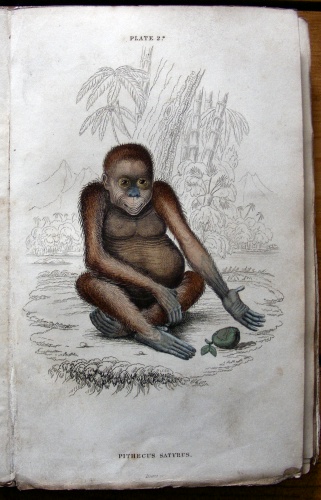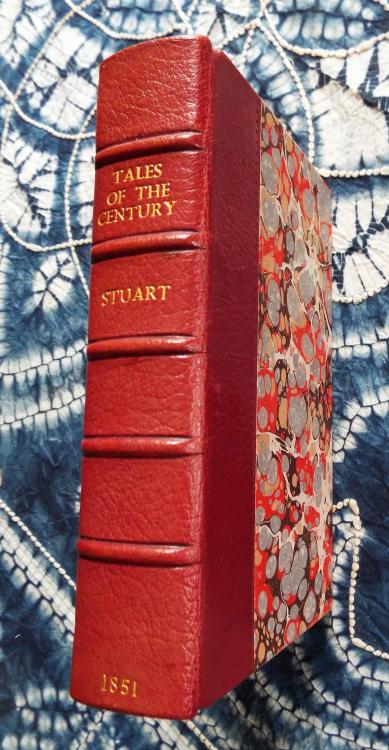
Sobieski (John) and Charles Edward Stuart, otherwise John Carter Allen or John Hay Allan, and Charles Manning Allan or Charles Stewart Hay Allan.
Tales of the Century or Sketches of the Romance of History Between the Years 1746 and 1846.
Edinburgh, Martin and Company. 1851.: 1851
- $274
Nicely bound in generous modern quarter dark red morocco, raised bands, gilt, marbled sides, all edges gilt. Lithotint frontispiece (joint between it and title-page slightly split), ppxii, 230 (Tales), 1-300 (various Notes). First Edition. A series of tales and jottings "credible because (they are) improbable" (intro) by the remarkable Sobieski Stewarts, the "de jure monarch(s) of England in place of the then reigning sovereign Queen Victoria", claiming to be, quite without justification or evidence, the Grandsons of the Pretender. Their claim drew the support of men of rank and intelligence, but was "absolute fabrication" (Walter Scott), who suggested that they were "men of warm imaginations . of much accomplishment but little probity". "Shot through with pure fantasy and bare faced forgery." Trevor-Roper. Chapters include The Prince's Long Incognito and The Arrest of Charles Edward.
More from Nicholas Goodyer

The Magnificent Botanical Library of the Stiftung fur Botanik, Vaduz, Liechtenstein, Collected by the Late Arpad Plesch. Parts 1-3 Complete.
Plesch Library: 3 volumes 4to, original boards, minor bump to one corner, otherwise, clean and fresh. Many plates, some coloured. 863 lots, all fully described, many with copious bibliographical notes, with buyer's names and price lists. Usually found with dusty or soiled covers, this is an excellent copy of one of the finest botanical libraries at auction.- $211
- $211
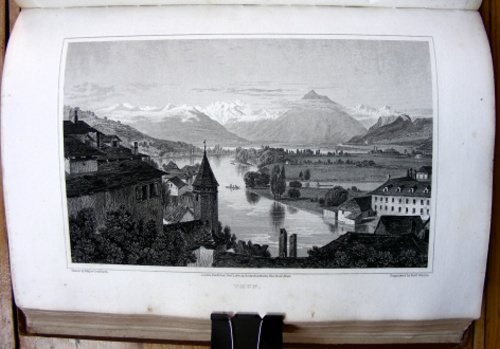
Swiss Scenery.
Cockburn (Major.) 4to (7.5 x 10 3/4, 190 x 270mm) contemporary half calf, gilt, top joint a little worn and split at head of backstrip. Engraved title-page, 60 steel plates. A little foxing (mainly marginal) and occasional offset. "Carefully and truthfully drawn, architecture correct in its proportions" DNB. A European tourist since the age of 13, Batty served under Wellington in both the Peninsular war and Waterloo campaign.- $407
- $407
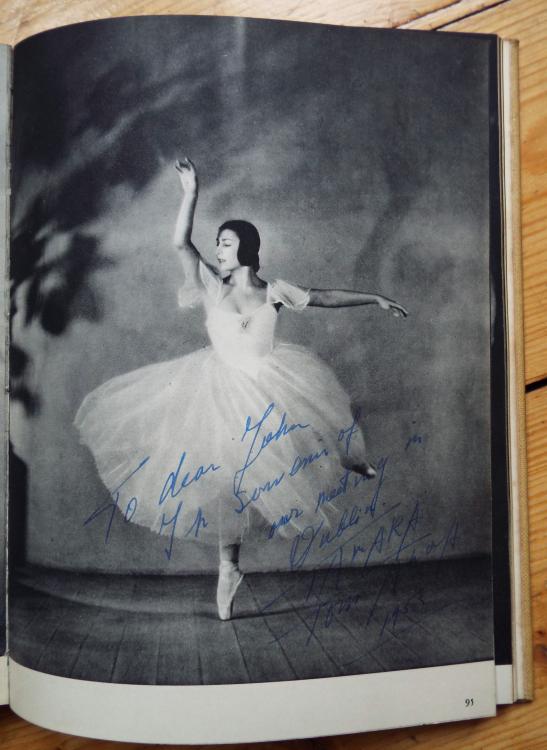
Ballet -To Poland. Decorated by Kay Ambrose. In Aid of the Polish Relief Fund.
Haskell (Arnold L.) Ed: Tall 4to (7 1/2 x 10ins, 200 x 250mm) bright in original buckram cloth with gilt lettering and motif to top cover. pp (154). Very light foxing to a few leaves. Essays and letters from the great and the good of contemporary ballet and theatre - Geligud, Masefield, Schaverell Sitwell, Victor Dandré, Ninette de Valois, Constant Lambert, W de.Basil et al., illustrated throughout with text illustrations by Kay Ambrose and plates after McKnight Kauffer, Pavlova, Felix Topolski, Oliver Messel, Cecil Beaton et al., some never before published. "Abums" of photographs, some pp58, of the greatest performers - Helpman, Fonteyn, Pavlova, Nijinski, and stars of the Russian and Polish ballets. "This Edition is limited to One Hundred copies. This is No.26" and signed by Haskell and Ambrose. Additionally in this copy 4 of the photographs have been autographed :Tamara Toumanova 1954, Pamela May, June Brae, Margot Fonteyn.- $274
- $274
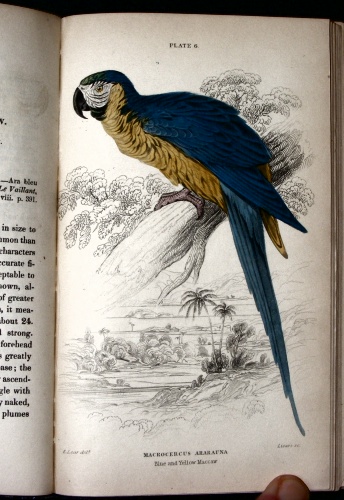
Parrots.
Jardine: Later grey cloth, uncut. Engraved portrait, coloured -title-page, 30 hand-coloured engraved plates after Edward Lear. One plate just trimmed (African Grey), otherwise good margins. The issue with the hand-coloured parrots against full engraved background scenery (not just a branch as in some late issues). Getting to be a difficult book to find. Series: Naturalists' Library.- $597
- $597
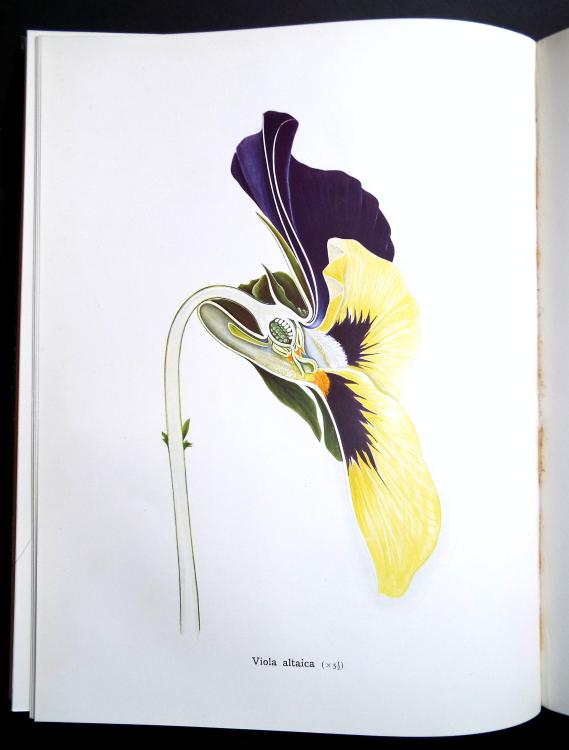
Types of Floral Mechanism A Selection of Diagrams and Descriptions of Common Flowers. Part 1, Types 1-XII. (All Published).
Church (Arthur Harry). Substantial 4to (10 x 10 3/4 ins, 250 x 320mm) very small and faint dark mark to backstrip, otherwise Fine Condition in publisher's green pebble cloth, backtrip gilt. pp vii, 211, monochrome plates, text illustrations and 39 extraordinary colour-printed plates, after Church's paintings. A project of "The Hundred Best Flowers" was proposed (intro), but after disagreements with Clarendon, Part 1 was all published, although he continued working on it until 1915. "An attempt has been made to strike a mean between prosy abstruseness. and imaginative flights." "Some of the finest (coloured illustrations) produced in modern times. their strikingly bold, almostJugendstil, images were used on greetings cards in the 1980s." ODNB quoting Mabberley's biography.- $414
- $414
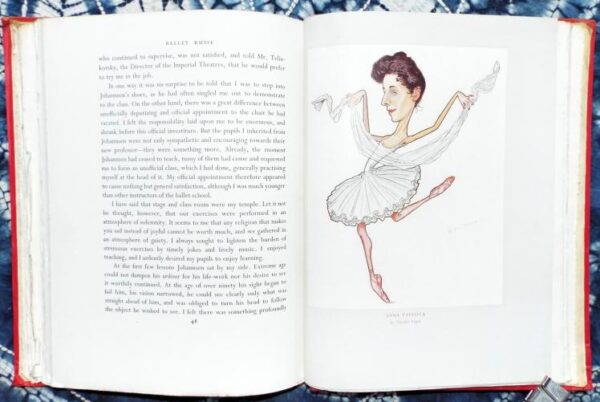
Ballet Russe, Memoir of Nicolas Legat Translated and with a Foreword by Sir Paul Dukes. Dedicatory Poem by John Masefield.
Legat (Nicolas)). 4to, publisher's red cloth, backs strip faded and a little rubbed at head, untrimmed. ppxv, 67, with 7 plates in colour and 24 "monotone". Very light foxing to a very few leaves. Masefield's dedication with printed signature. First Edition. The 3 appendices pay tribute to Pavlova, and list ballets in which Legat appeared, and those he produced. "He lived with one ideal. to transmit his learning to succeeding generations and keep alight the torch. (of) St Petersburg in the last decades of the Ninetenth Century" (Foreword) both as performer and later as teacher and ballet master.- $126
- $126
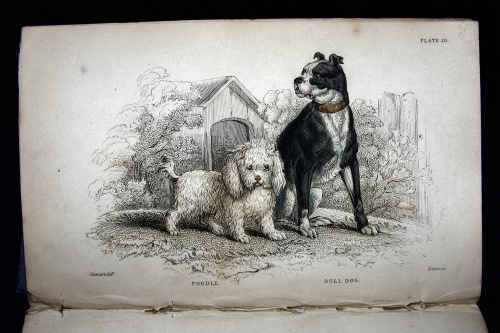
Dogs.) Mammalia.Canidae. Volume 2 (Volume X of Mammalia).
Jardine (Sir W.) Later grey cloth, part of original backstrip retained as label. Engraved portfait, title, 4 uncoloured plates, 31 hand-coloued steel engraved plates, this First Edition with the uncoloured backgrounds. A little light browning, overall good conditon . Volume 2 illustrates and describes mostly domestic dogs, their wild ancestors being in Volume 1.- $211
- $211
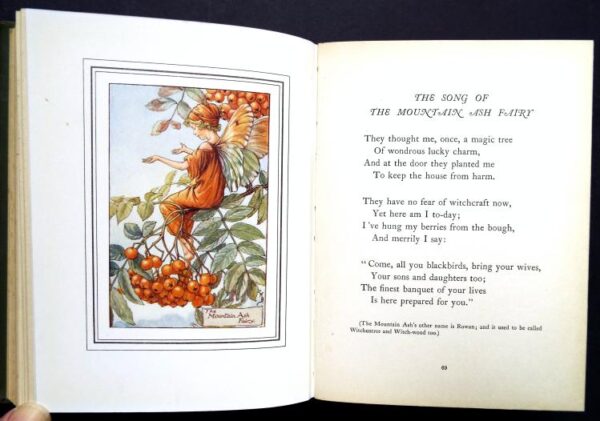
The Book of Flower Fairies.
Barker (Cicely Mary) Publisher's green cloth, gilt, untrimmed and complete with the 72 colour-printed Flower Fairy plates plus text illustrations. Front end-paper neatly cut out, free end-paper affixed to inside cover, neat inscription to foot of half-title. Bright, crisp copy. An early issue, the plates with their decorative ruled borders and the tallest format (6 x 7.5 ins, 145 x 190mm). A compilation of Flower Fairies of the Spring, Summer and Autumn.- $168
- $168
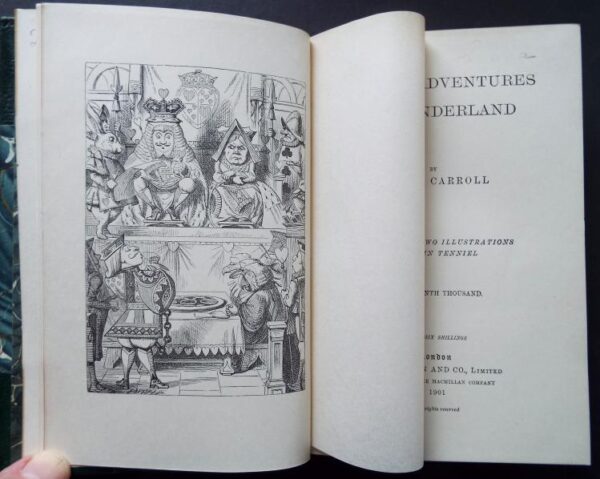
Alice’s Adventures in Wonderland. With Forty-Two Illustrations by John Tenniel. Together with: Through the Looking-Glass and What Alice Found There. With Fifty Illustrations by John Tenniel.
Carroll (Lewis), Rev.Charles Dodgson. Uniformly finely bound in contemporary three-quarters dark green morocco, marbled sides, backstrips with raised bands, 5 panels, gilt with a rose motif, top edges gilt. Alice: half-title, frontispiece, pp (viii), 192. Through the Looking-Glass: half-title, leaf of the chess game, frontispiece, (ix), 224. Both volumes have a leaf Christmas Greetings (From A Fairy To A Child.) dated 1887, paginated 195 in Alice and 227 in Looking-Glass and bound-in at the end, the intervening blank having been removed in rebinding. Williams 162. A Fine Pair, with the bookplate of Louise Whitfield Carnegie, wife of Andrew Carnegie. The couple "jointly helped the creation of over 2,500 libraries between 1883 and 1929." Wikipedia.- $842
- $842
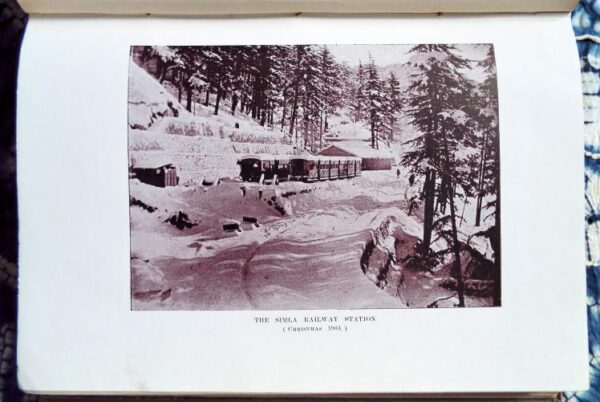
Simla Past and Present. With Illustrations.
Buck (Edward J.) Substantial Royal 8vo (7 1/2 x 10ins, 190 x 260mm) publisher's printed buckram, beveled edges, untrimmed, lettering on backstrip faded, carefully recased. pp xiv, 270, advertisement leaf. Folding map, 51 plates, mostly after photographs, a few leaves discoloured or slightly foxed. Only Edition. With an early photograph of Simla noting several places on verso, and an early typed pp5 essay by Sita Ram Kohli on the Trial of Diwan Mul Raj, Governer of Multan.- $316
- $316
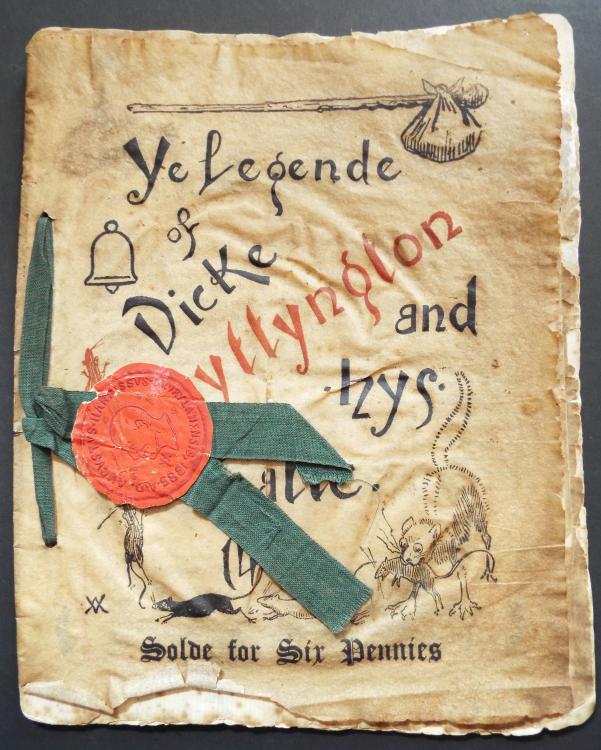
Ye Legende of Dicke Whyttington and hys Catte. 1420. Solde for Six Pennies. Ye Wrytinge of Ye Legends bye Horace Lennard. Ye Pictures bye Wallis MacKaye.
Lennard (Horace). 4to (8 3/4 x 11ins, 220 x 275mm) original deliberately aged vellum covers (now rather brittle), printed red and black, original green linen ties with red paper seal, printed with portrait of Augustus Harris, the completely untrimmed edges now rather more worn than even the the distressed original. Tipped-in notice explaining this re-imagining of the legend, pp (16), final leaf listing Harris' pantomimes at Crystal Palace, and Theatre Royal Drury Lane. Illustrated throughout in red and black to accompany the verse text. Marginal foxing. A rare survival, 2 copies recorded in the UK, 2 in US, 1 in Amsterdam. Son of a famous theatrical manager father, also Augustus Frederick Glossop Harris, following some years of successful acting, producing and management in music hall and theatre, Augustus junior leased the Theatre Royal in Drury Lane, his celebrated and popular pantomimes subsidizing Opera productions such as the first production of Meistersinger, and Tristan and Isolde (first outside Germany), as well as other less popular pieces whose plots were "long and bewildering". The pantomimes cast Dan Leno, Vesta Tilley, Marie Lloyd, Little Titch, and both pantomimes and other productions were famous for their lavish scenery and parades, even involving Major Kitchener to arrange marching sequences. His innovations such as electric lighting, dark auditoriums during a performance, and courageously promoting Opera in languages other than Italian, set the standard of the day. Our Whyttington is no longer the innocent country lad, but a turbaned African youth, setting ashore at the white cliffs where John Bull has no cats. After being pulled up by Constable Bowbelles on Highgate Hill (a Victorian stop-and-search), the pestilential plague of rats is dispersed, and Dick's journey continues meeting William Booth, paying income tax to Gladstone, being entranced by his many visits to the Belles of the Drury Lane Theatre accompanying the Prince of Wales, and receiving honours from Queen Victoria. He returns home a rich man to his waiting sweetheart, founds a corporation, where he as Lord Mayor grew toothless old and fat, "And this is how ye stories run, which telle of Dyckie Whyttington".- $807
- $807
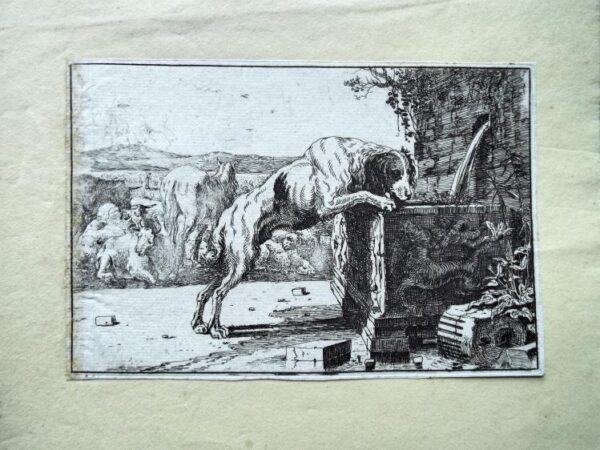
The Zoographia (Descriptions of Animals) Known as.
Hecke (Jan van den). A Collection of 9 etchings, each approx 165 x 110mm, 6.5 x 4.5ins, with ruled margins (none trimmed), mounted up to 8.2 x 6.7ins, 270 x 170mm on contemporary straw coloured paper, the plates just edge mounted on one side or corner, several now loose, all in good condition, clean and fresh, now protected in a custom case. The full suite is 12, we have 1-2, 4-5, 7, 9-12. Dedication on Plate 1 "Magnificentissimo principi Paulo Iordano Bracciani duci. fecit aqua forti Johannes vanden Hecke". Delightful, sensitive and humorous etchings, delicately illustrating farm and domestic animals - dogs (4), horses, donkeys, cattle, sheep, a stray squirrel - in a mixture of ruined classical and dilapidated rustic farmyard settings. Working firstly in Antwerp, later Brussels before finally returning to Antwerp, Van den Hecke visited Rome on several occasions between 1644 and 1658, that classical influence being evident in these lovely etchings. He was particularly noted for his canvases of flowers, plants and his still lives, his patron the Duke of Bracciano being a celebrated collector.- $1,544
- $1,544
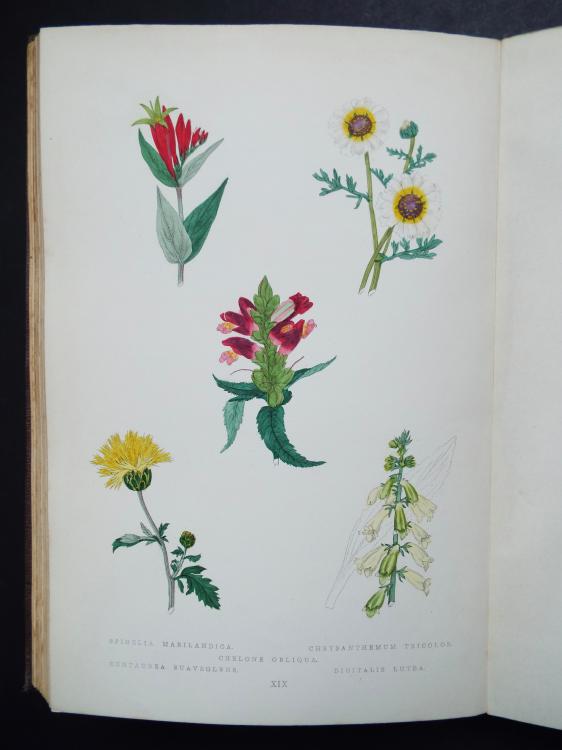
The Botanic Garden. Ed: J.C.Niven.
Maund (B.) 6 volumes Roy8vo (7 x 10in.,180 x 260mm) original mauve stamped cloth, gilt, chips and splits to backstrips of several volumes, untrimmed, so in the tallest possible state. 250 Hand Coloured Plates,arranged 5 to a page. Very sight and occasional spotting to untrimmed edges, otherwise internally a crisp set of the Second Edition. The usual issue of the First Edition is about 6 x 8 ins, 150 x 200mm, so considerably smaller page size, with 4 figures and ruled divisions.- $983
- $983

Fishing Tackle of Quality. 1938 Edition.
Alexander Martin: Original black and gilt stapled pictorial card covers - an embossed, gilt, hooked trout, and fishing tackle - Scottish fishing resort map to rear, very slight bump to lower edge. pp136, illustrated throughout, pp14 are in full colour - mostly flies and rods - includes shotguns and cartridges etc. Sticker tipped in from Stand T24 North of the Palace of Industry Exhibition, Empire Exhibition, Glasgow 1938, order form loose inside back cover. Game, Coarse and Sea fishing, rods reels, bags and every accesssory. An exceptionally nice catalogue in very good condition. The fourth generation, established over 130 years ago.- $105
- $105
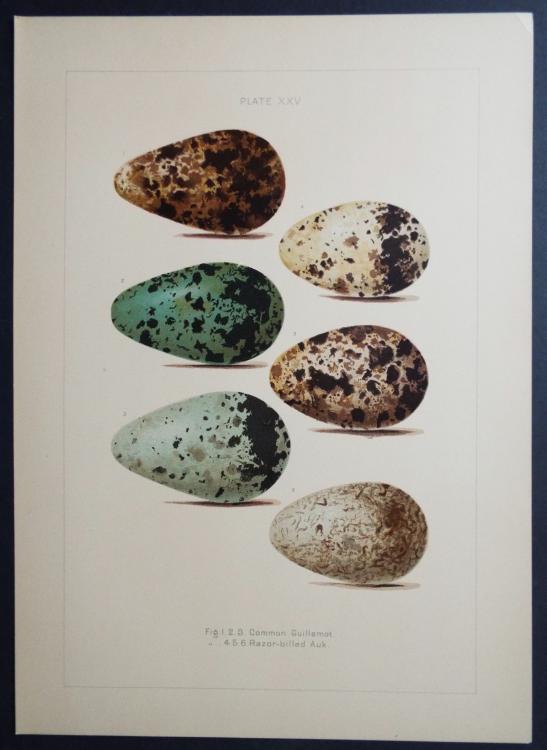
Oölogy of New England: A Description of the Eggs, Nests and Breeding Habits of the Birds Known to Breed in New England with Coloured Illustrations of Their Eggs.
Capen (Elwin A.) Tall folio (10 1/2 x 14ins, 270 x 375mm). Text and plates loose and unbound (see below) in original black cloth box, small splits, a little rubbed, but very good. pp 116. "25 full page plates of eggs, representing several hundred, beautifully coloured. Notably complete and good". ( Bennett, American Nineteenth Century Colour Plate Books). The dramatic colour printed plates show 323 eggs, decoratively arranged on each plate with ruled border and captioned, most images far larger than usual, and printed on a straw-coloured or very light-green card stock. This has become a scarce book, and is the first copy I have seen in many years. Quite the largest format of its sort and the only one on American Birds Eggs. The Finest Possible Copy. " This magnificent volume. has long been out of print. Last Summer amongst the effects of the late E.A Capen a few copies of this valuable work, uncut, untrimmed and unbound, but each copy assembled and wrapped ready for the binder were unearthed, and. the undersigned secured them. The few copies I possess are being distributed among my old. friends." From the label affixed to the top of the box, in the name of Frank H. Lattin M.D., Albion. N.Y.- $2,026
- $2,026
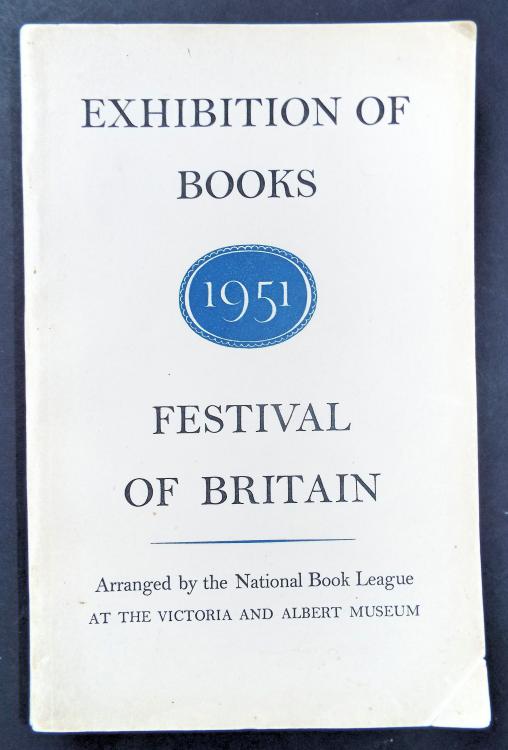
The Festival of Britain Exhibition of Books. Arranged by the National Book League at the Victoria and Albert Museum.
London: Exhibition of Books. Original stiff card covers, blue and black printed. Pp224. "It is safe to predict that this Exhibition will come to be regarded as. one the like of which has never been assembled before." Norman Birkett's introduction to this extensive catalogue. A very nice copy. Very much the precursor of Printing and the Mind of Man in 1963.- $55
- $55
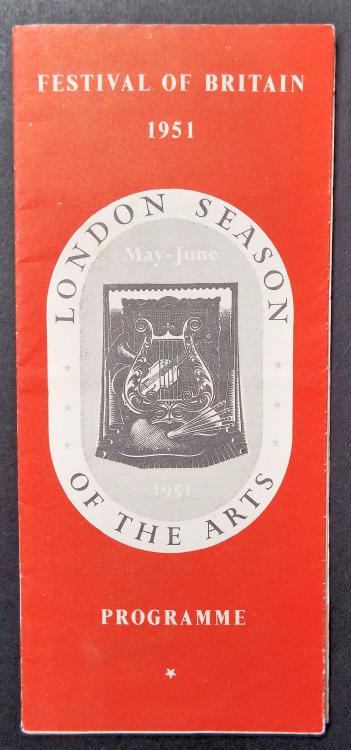
Programme. London Season of the Arts May-June.
London: Festival of Britain 1951. Folding programme sheet (360mm x 600mm, 14 x 24ins) illustrated and colour printed both sides, with map of venues, detailing events at Theatres, Concert Halls and Art Galleries during Summer of the Festival year, and the distinguished performers.- $36
- $36
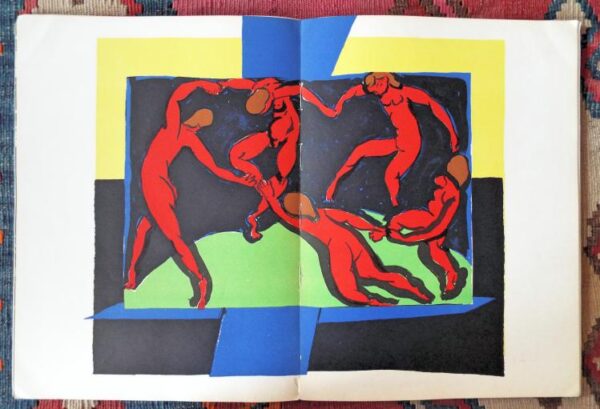
Verve. An Artistic and Literary Quarterly. (Volume 1) No,4. Director E.Tériade.
Verve: Folio 260 x 255mm, 10.5 x 14ins. Coloured stiff wrapper specially designed by Rouault, backstrip rubbed, internally very good. A Who's Who of the Fine Arts. Texts by Garcia-Lorca, Sartre, Paul Valéry. Marie Renard (model to Berthe Morizot (sic)), et al., reproductions, many in colour, of works by Rembrandt, Courbet, Lautrec, Miro, Rousseau, Rouault, Rubens, Doré, classical suites of "Grandes Heures" and medieval works finished in gold, Tintoretto, Degas, photographs by BrassaÏ, Bill Brandt (Gustav Doré's London Rediscovered series), Maywald (Seurat to Monet) et al. Original Lithographs: 8 original lithographs "Tacuinum Sanitatis Fourteenth Century Book of Health". Derain, Garden of Allah (6 pieces). Matisse, a specially commissioned double-page La Danse with 2 further lino cuts on versos (Figures of Skaters), 5 further reproductions of Matisse throughout. The English Language Edition, issued simultaneously with the French.- $695
- $695
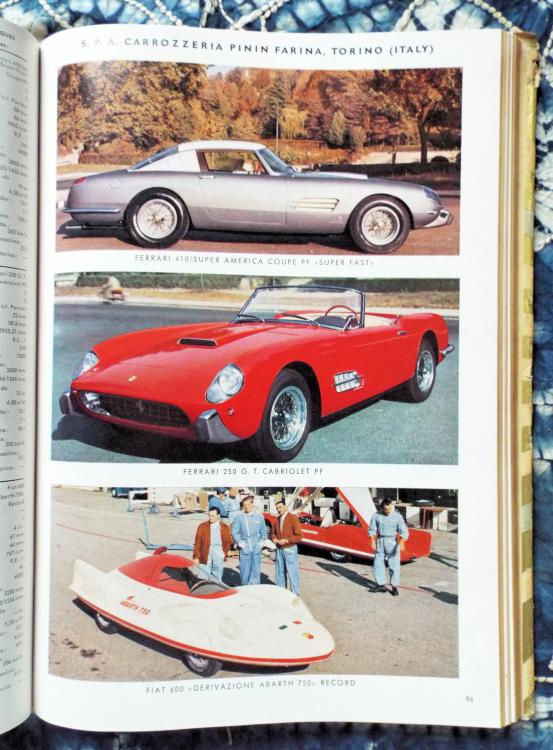
Internatioal Automobile Parade. (The same in German and French.)
Logoz, Arthur. Tall 4to (215 x 300mm, 8 1/2 x 12ins) publisher's cloth-backed printed boards, the fine photographic and gilt dust jacket "Auto-Parade" bright but with a few small chips missing. pp (ix), 291, 97 coloured photographic plates with 291 images. With the pink errata slip loose. Preface in English, French, German, Italian, Spanish and Portuguese. 2nd Edition or Volume 2. Exceptional copy. Italian, English, German, French, USA, Swedish, Czecho-Slovakian, Australian, Swiss and DDR cars make up this fabulous catalogue of stylish and fabulous automobile dreams. Full technical details including ex-works prices, and some road test reviews by "Phaeton".- $133
- $133
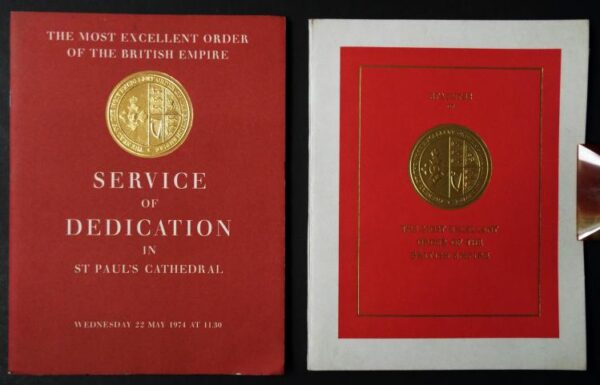
Statutes of the Most Excellent Order of the British Empire 1957. Together with: Service of Dedication in St Paul’s Cathedral, Wednesday 22 May 1974.
Order of the British Empire: 2 items folio (8 1/2 x 11ins, 215 x 285mm) original maroon stiff card covers, gilt and in fine condition. Statutes: pp67, 7 monochrome plates. 3 letters to Richard Gronow Hinks MBE from the Registrar of the OBE concerning fund raising and dedication of the chapel in St Pauls, signed receipt of One Pound's donation (the maximum permitted) to the funds of the chapel. Service: pp2 p printed red and black, coloured frontispiece and plate. With invitation and dress and transport instructions.- $109
- $109
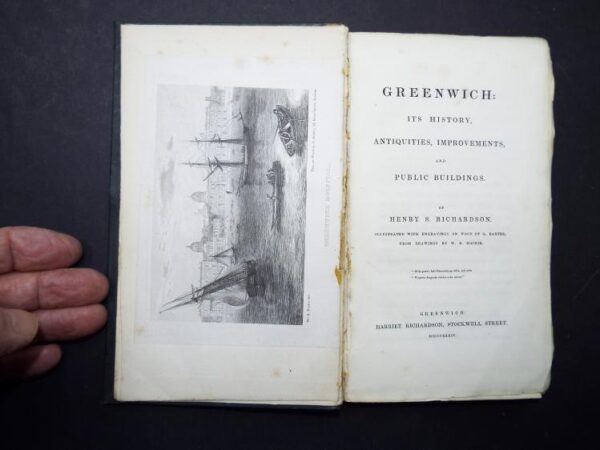
Greenwich: Its History, Antiquities, Improvements, and Public Buildings.
Richardson (Henry S.) Slim 8vo, original green cloth, anchor motif to backtrip, top joint split, untrimmed. 3 wood engraved plates by G.Baxter after W.B.Mackie, pp 130, corrections leaf, advertisements. Priced to allow for the recasing the copy merits.- $65
- $65
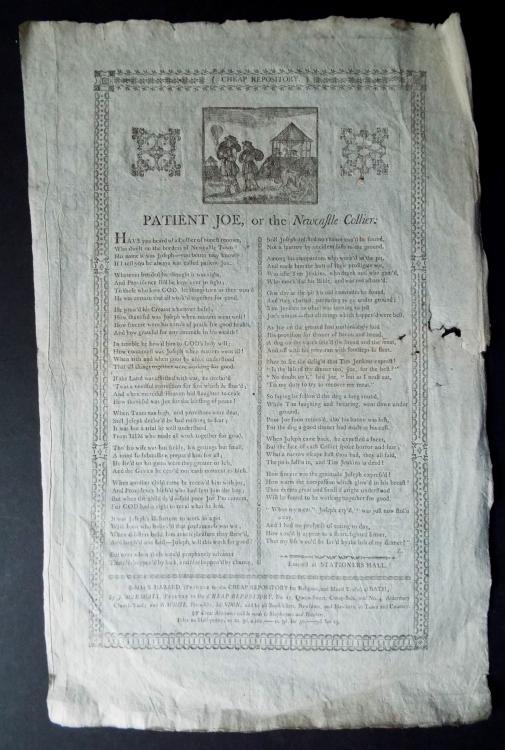
Patient Joe, or the Newcastle Collier.
Broadside: (Hannah More). Broadside (11 x 18ins, 280 x 445mm) printed slightly off-centre on the sheet, paper fault in one margin, just into the printed surface, but very crisp, on laid paper. Decorative engraved border, 18 verses signed "Z", wood-engraved head-piece of Joe, the unfortunate Tim Jenkins, the dog stealing Joe's dinner, with a horse powered pit-head in the background. Reprinted in later bound collections, this is the original format. "The threat of war and revolution impelled her to write dozens of. tales specifically for the lower classes that were published anonymously. and distributed by booksellers and peddlers across the country." ODNB.- $270
- $270
Tales of the Century or Sketches of the Romance of History Between the Years 1746 and 1846.: https://rarebookinsider.com/rare-books/tales-of-the-century-or-sketches-of-the-romance-of-history-between-the-years-1746-and-1846/
